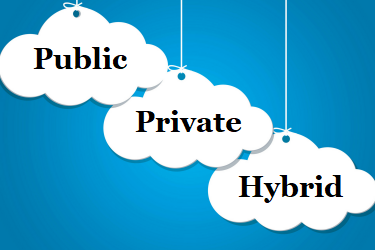August 21, 2018 by Siobhan Climer
Private? Public? Hybrid? On-premise only? Choosing how – and if – to implement cloud solutions for your business can be a risky endeavor. Today, we’ll be providing an overview of the ‘Great Cloud Debate’, and how businesses come to the decision to either stay on-prem or move to the cloud.
Is The Cloud Right For My Business?
 First things first. If your business is looking at how to implement cloud solutions to support business imperatives, you need to decide if the cloud is the right next step. While the cloud offers many benefits, such as increased accessibility, scalability, and efficiency, it can also be a hindrance if poorly implemented or thoughtlessly maintained. Security protocols, collaboration processes, and backup and disaster recovery procedures will require modification. Decision-makers will need to be fully invested in using the cloud strategically to support business needs.
First things first. If your business is looking at how to implement cloud solutions to support business imperatives, you need to decide if the cloud is the right next step. While the cloud offers many benefits, such as increased accessibility, scalability, and efficiency, it can also be a hindrance if poorly implemented or thoughtlessly maintained. Security protocols, collaboration processes, and backup and disaster recovery procedures will require modification. Decision-makers will need to be fully invested in using the cloud strategically to support business needs.
Performing a risk assessment puts you in a position to make the business case for moving to the cloud. The risk assessment examines what impact a cloud solution and cloud service provider will have on your business. Finding the right cloud solution – and the right trusted partner to manage your cloud infrastructure – is essential. Risk is present in any digital transformation. By proactively examining risk and preparing for the transition, your business can make the right choice for its present – and future – needs.
Types Of Cloud Solutions
 When it comes to figuring out how to implement cloud solutions for your business, you also need to determine which type of cloud solution you’re after. Essentially, there are three main categories you’ll need to examine:
When it comes to figuring out how to implement cloud solutions for your business, you also need to determine which type of cloud solution you’re after. Essentially, there are three main categories you’ll need to examine:
- Private vs. Public vs. Hybrid deployment models
- AWS vs. Azure (Public Providers) vs. Local Provider vs. Hybrid
- SaaS vs. IaaS vs. PaaS service delivery models
Each business’ strategy for how to implement cloud solutions will vary based on these decisions and, even more fundamentally, on the business’ needs. For example, let’s walk through the steps a local ambulatory care center might take.
First, they decide to use a hybrid cloud model, since some of their data needs to be easily accessible and scalable (webmail and collaboration tools), while other sensitive data, which needs to be HIPAA, GINA, and state-regulatory compliant, can have designated storage on-premise.
Second, they decide to use a local provider, like Mindsight, because they want the expertise, communication, and trust that comes with a reliable, local partner.
Third, they decide to use a Software-as-a-Service (SaaS) model, since the way they hope to use the cloud is to improve collaboration and communication with cloud software tools. Hosting applications in the cloud eliminates the need to install and run applications on individual computers. This also creates accessibility across the organization. SaaS enables better communication between ambulances and emergency directory services, improved team dynamics, and the patient-centric focus the business believes in.
Another organization might find a lot of benefit in a public cloud provider and infrastructure-as-a-service (IaaS), so they can offload their storage, security, and monitoring needs to someone else. Still another might choose a private cloud provider and a PaaS model, putting their middleware, dev tools, BI services, servers, and everything else, in the hands of a trustworthy, risk-minimal organization. As you can see, it is the business imperatives that drive how to implement cloud solutions, and those imperatives are different for every business.
Migration Trepidation: How To Implement Cloud Solutions
Once you’ve decided on a cloud deployment model, the next step is strategy. Moving to the cloud in any capacity requires careful planning and leadership. Poorly executed cloud migrations increase risk dramatically; data loss, process failures, and mission-critical business imperatives can fail.
At the same time, of course, risk can’t stop progress. If moving to the cloud is the right next step, you need to determine a migration plan and execute it. You will need to consider how to migrate without application errors, how to execute a migration in a timely manner, how to mitigate risk and downtime, and how to minimize the impact on your end users.
Use Expert Help
One way to ensure you have a thoughtfully-vetted execution plan is to bring in a cloud solutions partner. They can show you how to implement cloud solutions and mitigate risk, offering you a smooth path through what can otherwise be a hazardous journey. By using industry experience, technical expertise, and a forward-thinking mindset, a cloud solutions partner can be your ticket on the train to the cloud.
Contact us today to discuss how to implement cloud solutions for your business.
Like what you read?
About Mindsight
Mindsight, a Chicago IT services provider, is an extension of your team. Our culture is built on transparency and trust, and our team is made up of extraordinary people – the kinds of people you would hire. We have one of the largest expert-level engineering teams delivering the full spectrum of IT services and solutions, from cloud to infrastructure, collaboration to contact center. Our highly-certified engineers and process-oriented excellence have certainly been key to our success. But what really sets us apart is our straightforward and honest approach to every conversation, whether it is for an emerging business or global enterprise. Our customers rely on our thought leadership, responsiveness, and dedication to solving their toughest technology challenges.
Contact us at GoMindsight.com.
About The Author
Siobhan Climer, Science and Technology Writer for Mindsight, writes about technology trends in education, healthcare, and business. She previously taught STEM programs in elementary classrooms and museums, and writes extensively about cybersecurity, disaster recovery, cloud services, backups, data storage, network infrastructure, and the contact center. When she’s not writing tech, she’s writing fantasy, gardening, and exploring the world with her twin two-year old daughters. Find her on twitter @techtalksio.
What Is Cloud Storage Part 1: An Overview Of Cloud Computing Basics


